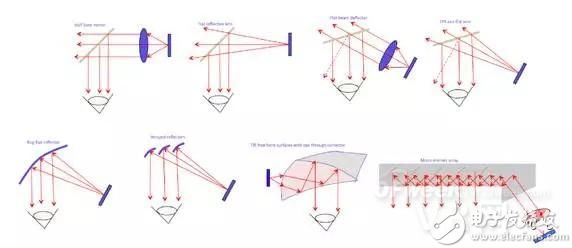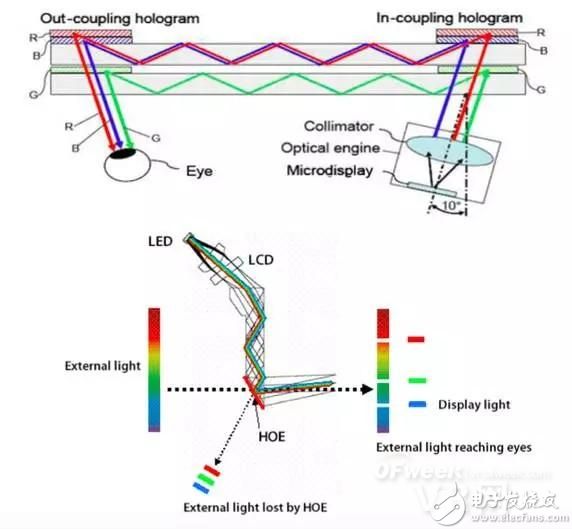Since the late 1960s, perspective displays have a wide history (I will add some content to help readers get more technical background). As a result, many optical technologies have emerged, but all of this comes down to the fundamental trade-offs between resolution, field of view, eye box, image quality, hardware weight/adaptation, aesthetic form factor, and other features. Ideally, everyone wants a stylish, 200x100 degree FOV (like the human eye) easy to use glasses and perfect image quality. But the physical and optical limitations of HMD / NED (such as how we use wearable hardware to reflect and bend light) make these unrealistic for the foreseeable future. So we need to figure out the trade-offs we care about.
Optical hardware is a trade-off.
Traditional combiners produce reasonable perspective and consistent quality imaging and materials that can be afforded for decades of supply chain development. We can talk about two common implementations, as shown in the following figure: a polarized beam combiner (upper left) as an example of a planar combiner and an off-axis combiner (upper right) as an example of a curved combiner.

Examples of polarized beam combiners include Google Glass and smart glasses from Epson (Japan), Rockchip (China), and ITRI (Taiwan). Beam splitters can be polarized using LCOS microdisplays, such as Google Glass, or simply using a halftone mirror. Unfortunately, PBC-based displays tend to be small due to the weight and size limitations of the combiner, and there may be additional ambiguity due to beam splitting. Google Glass has a 13-degree FOV; the Epson BT-300 has a 23-degree FOV and a resolution of 1280x720. Both are low-end products that are acceptable for consumer displays. However, larger FOV and/or resolution will require larger and heavier hardware.

The best example of an off-axis, hemispherical combiner is Meta 2. Unlike other small and light combiners, Meta tends to have greater FOV and display resolution. They introduced a single OLED panel to support "near 90 degree FOV" and binocular 2560x1440 pixel display. However, their hardware is huge and comparable to VR headsets such as Oculus and HTC Vive. In addition, there are problems with low angular resolution (less detailed/clear images) and how the combiner plastic material maintains its mass (for example, slight disturbances are magnified and changes over time may create visual artifacts) - so They choose to reduce costs. A common example of using a curved combiner is Link's advanced helmet-mounted display.
As you can see, trying to improve the traditional combiner in terms of FOV and resolution means smaller outer casings, thicker combiner optics, larger combiners in the distance, and worse image quality. It's not about computational performance limitations, but about the physical factors of how light interacts with hardware.
In order to solve the headaches of trade-offs, new technologies are advancing the development of unconventional technologies such as holography and diffractive optics. These techniques use so-called waveguide gratings or waveguide holograms to progressively extract collimated images guided by total internal reflection (TIR) ​​in the waveguide. A pipe is a glass or plastic sheet through which light can pass. In fact, you can imagine a router's waveguide that presents an image on the eye.

Technically, waveguides are the most complex perspective optics and are equally difficult to design. However, these ideas are not up to date; people have been exploring optical waveguides since the early 1980s. Since then, companies such as Sony (above), Konica/Minolta (pictured above), Nokia/Microsoft (pictured below), and Magic Leap have been developing various waveguide combiners.

For example, a surface floating tilt sub-wavelength grating is used by Microsoft Hololens. Here, the waveguide has a series of very fine structures on a linear pattern. The diffraction grating, like a lens, bends the light through the TIR until it is directed toward the eye. The best result of this process is "pupil expansion"; the exiting light can be slightly diffused to increase its FOV.
All in all, the most advanced waveguide technology can reach 1920x1080 resolution, close to 32Hx18V FOV, and without the size and weight of a traditional combiner solution. The Magic Leap patent indicates that its technology is eager to approach the 120Vx80V level FOV, but may eventually reach 50-55 degrees FOV. This may be more promising than the traditional approach, but it is also a promise that can be achieved so far. In addition, waveguide combiners have their own set of challenges.
First, waveguides require great precision and are very tricky, and volume holographic media such as photopolymers, DCGs, silver halides, etc. can change due to ambient temperature, humidity and/or pressure. Second, the angular resolution decays with diffusion (ie, the tradeoff of FOV to imaging detail). Finally, there is no supply chain for technology, so large-scale production is difficult and costly. Not to mention the high R&D costs of the two companies.
Mc4 Fuse Connector,Slocable Solar Pv Fuse,Mc4 Connector With Fuse,Mc4 Inline Fuse Connector
Sowell Electric CO., LTD. , https://www.sowellsolar.com